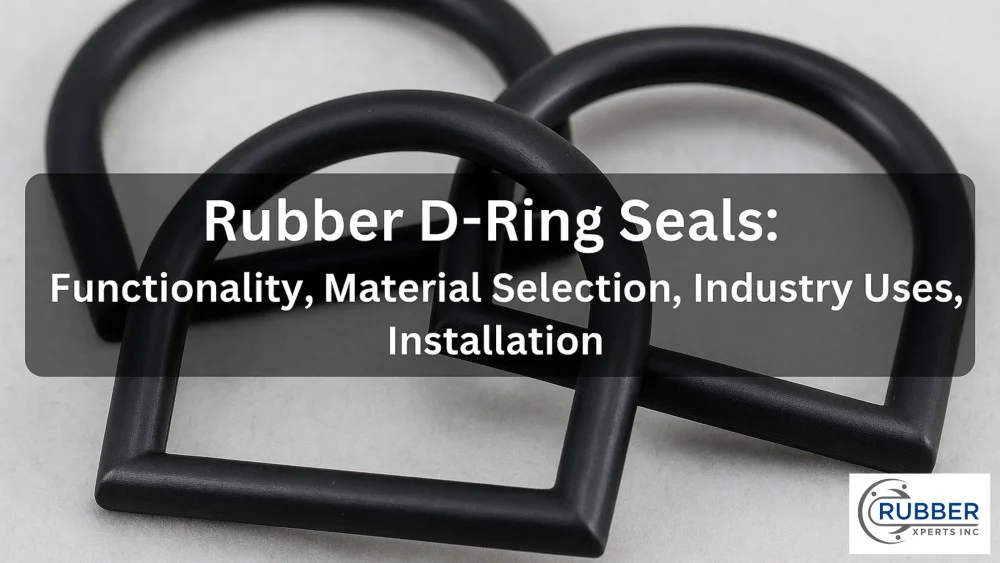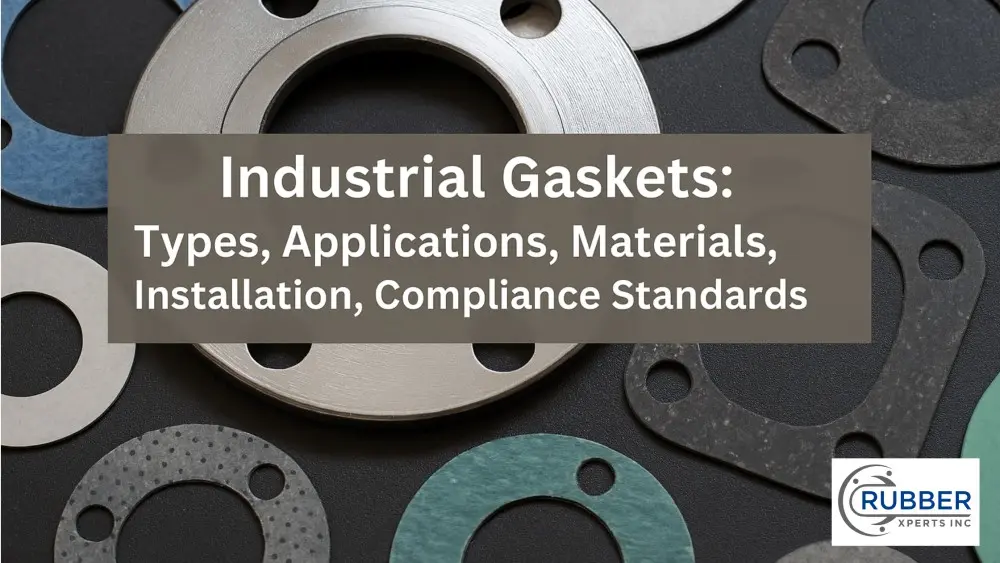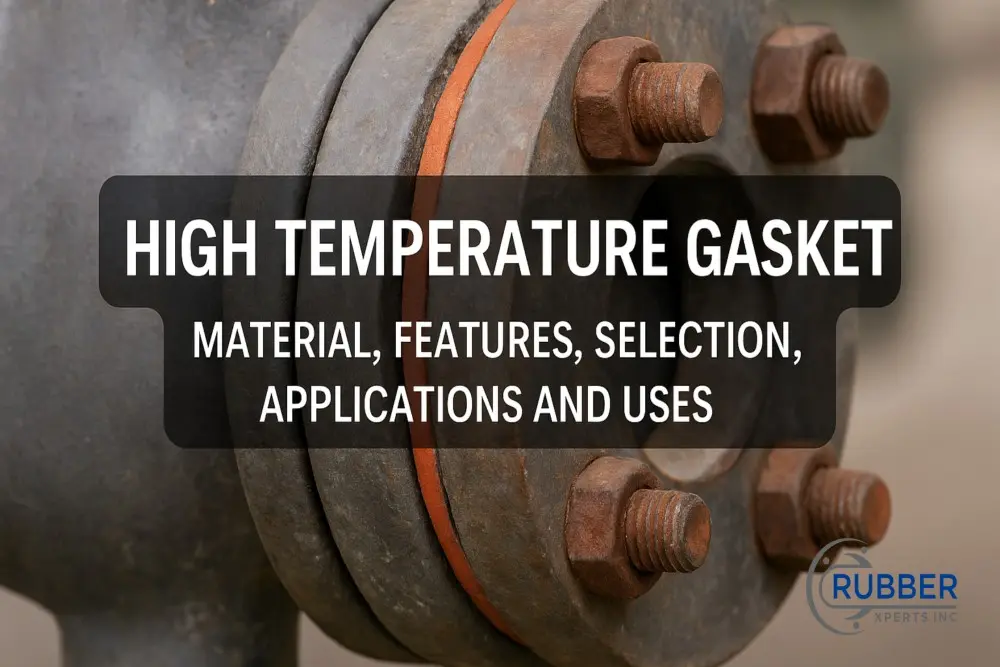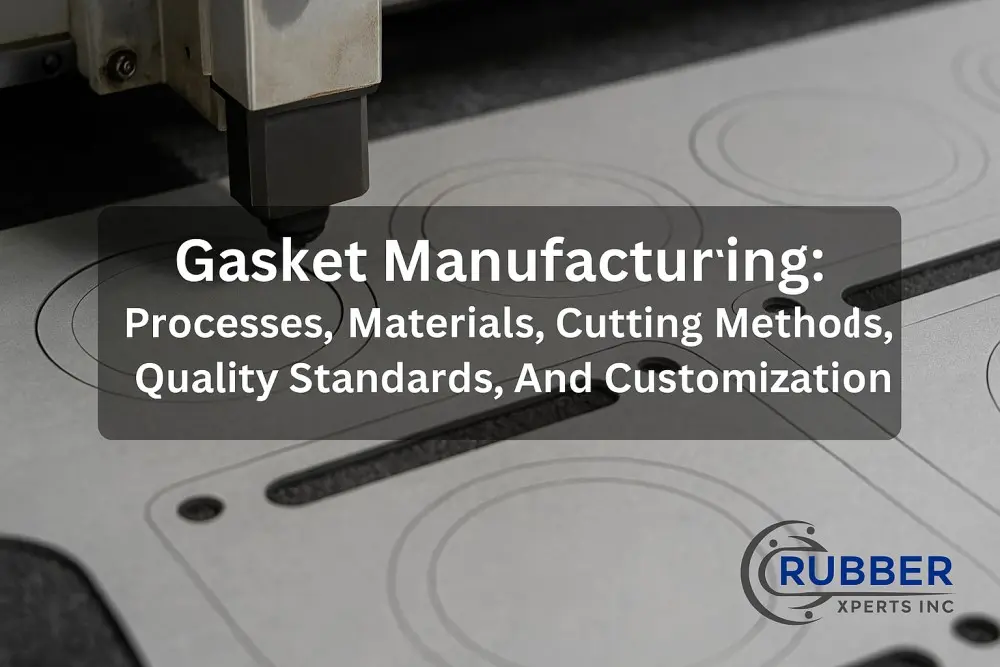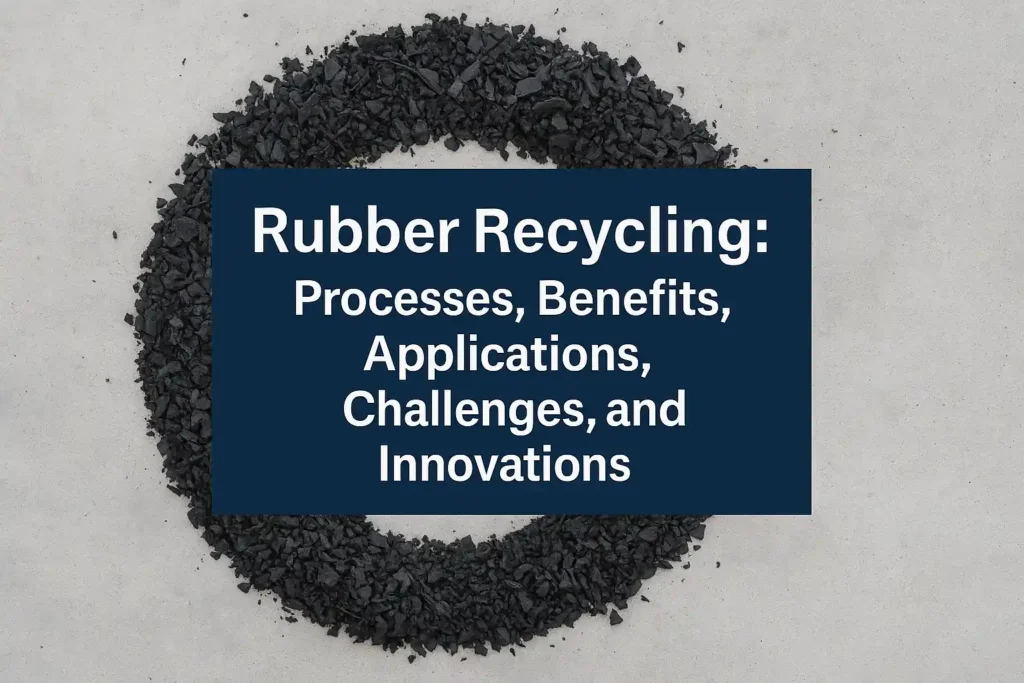Rubber resistance is the ability of rubber materials to withstand various environmental and operational conditions without significant degradation or loss of performance. The resistance properties of rubber are important for determining its suitability for different applications. These properties ensure that rubber components, such as seals, gaskets, and O-rings, maintain their integrity and functionality over extended periods, contributing to products’ overall durability, elasticity, and reliability.
Rubber resistance includes chemical, abrasion, temperature, and ozone resistance. Each type addresses a unique environmental impact that leads to premature failure if not properly managed. For example, chemical resistance ensures rubber components do not degrade when exposed to corrosive substances, while abrasion resistance helps rubber withstand wear from friction and mechanical stress.
The polymer behavior, material composition, and vulcanization process influence rubber resistance and contribute to its resilience. Elasticity and hardness are also important in ensuring that rubber deforms under stress and returns to its original shape without cracking or losing its resistance properties. These factors are paramount for producing rubber materials consistently in demanding environments.
Various testing methods, such as abrasion resistance testing, tensile strength testing, and chemical resistance testing, help determine rubber’s material properties under specific conditions. These tests are conducted according to established testing standards, such as ASTM and ISO guidelines, to ensure accurate and reliable performance evaluations. Testing ensures that rubber materials meet industry requirements and withstand the real-world conditions they are designed for.
Rubber resistance is integral to various industrial applications, including automotive, aerospace, medical devices, and construction. In automotive applications, rubber seals, gaskets, and tires benefit from high wear resistance, ensuring longevity and performance under harsh conditions. In the aerospace industry, rubber components must resist extreme temperatures and chemical exposure, while in medical applications, rubber’s chemical compatibility ensures the safety and effectiveness of products like medical tubing and seals.
Rubber resistance also has limitations, such as temperature sensitivity, ozone degradation, and limited chemical resistance, that affect its performance over time. These degradation factors lead to wear and tear, especially in high-stress environments. Rubber faces challenges in extreme conditions, such as exposure to harsh chemicals or prolonged UV radiation. Catering for these limitations is important to ensure the longevity and cost-effectiveness of rubber-based products in industrial applications.
What is Rubber Resistance?
Rubber resistance is the ability of rubber materials to withstand various physical, chemical, and environmental stresses without compromising their performance or structural integrity. This important property results from the unique combination of elasticity, polymer resilience, and material strength inherent in rubber compounds.
Rubbers are valued for their exceptional durability and resistance properties. These properties allow them to endure wear, pressure, and exposure to various challenging conditions, such as extreme temperatures, chemicals, and mechanical forces. These characteristics make rubber necessary for applications like creating reliable seals that prevent leakage and maintain system integrity in dynamic and static environments.
Elasticity enables rubber to stretch and return to its original shape, ensuring tight seals even under fluctuating pressures. Polymer resilience absorbs stress and recovers from deformation, enhancing the material’s longevity. Material strength and durability contribute to the rubber’s capacity to resist tearing, cracking, and degradation over time.
Different types of rubber, such as natural rubber, silicone, and nitrile, offer specific resistance properties tailored to various applications. Factors like temperature tolerance, chemical compatibility, and environmental exposure influence the selection of rubber materials. Rigorous testing methods, including tensile strength and aging tests, ensure the material meets performance standards. While rubber is versatile, it does have limitations, such as susceptibility to degradation in certain harsh chemicals or prolonged UV exposure.
What are the Different Types of Rubber Resistance?
The types of rubber resistance are chemical resistance, abrasion resistance, and temperature resistance. These resistances ensure rubber’s adaptability and durability in diverse applications, making it a vital material across industries.
The types of rubber resistance are as follows:
Chemical Resistance
Chemical resistance is a rubber’s ability to withstand degradation when exposed to various chemicals, including acids, alkalis, and solvents. This property is determined by the polymer structure and cross-link density, which prevent chemical molecules from penetrating or breaking down the material.
According to a study by Fritz HE et al. 1933 titled “The Chemical Resistance of Rubber as an Engineering Material,” the chemical compatibility of rubber varies significantly based on its molecular composition and the specific environmental conditions it encounters. The research explains that customized formulations enhance resistance to particular chemicals, allowing rubber to perform effectively in demanding industrial applications.
For example, nitrile rubber exhibits high oil resistance due to its polar molecular structure, making it important in applications like seals and hoses where exposure to oils or fuels is common.
Abrasion Resistance
Abrasion resistance is the capability of rubber to endure wear and tear caused by friction or mechanical stress. This property is important in conveyor belts, tires, and industrial rollers. High abrasion resistance is achieved through robust polymer resilience and material strength, enhanced with fillers like carbon black.
According to a study by Arayapranee W et al. 2012, titled “Rubber Abrasion Resistance,” reinforcing agents like silica and carbon black significantly improve the wear resistance of rubber compounds under dynamic stress. The research also emphasizes that the vulcanization process enhances the durability of rubber materials in high-friction applications. It ensures the longevity and reliability of rubber in demanding environments.
Temperature Resistance
Temperature resistance, or thermal resistance, describes a rubber’s ability to maintain its elasticity and performance across a wide temperature range. Silicone rubber, for instance, operates between -60°C and 200°C without losing its structural integrity. This makes it indispensable in extreme heat or cold applications, such as automotive gaskets and aerospace seals.
A study by Rajkumar K et al., 2011, titled “High-Temperature Resistance Properties of NBR Based Polymer Nanocomposites,” found that incorporating nanofillers like silica and carbon nanotubes significantly enhances the thermal stability of rubber compounds. The research also emphasizes that nitrile butadiene rubber (NBR) nanocomposites show improved resistance to thermal degradation, making them suitable for high-temperature industrial applications.
Weather Resistance
Weather resistance, including ozone resistance and UV resistance, ensures rubber’s durability under prolonged exposure to environmental elements. Ozone resistance prevents cracking caused by ozone in the atmosphere, while UV resistance protects against damage from sunlight. EPDM rubber is commonly used for outdoor applications due to its superior environmental resistance and ability to withstand water and temperature fluctuations.
According to a study by Wang Q et al. 2016, titled “Weather Aging Resistance of Different Rubber Modified Asphalts,” rubber modified with specific additives demonstrates exceptional resistance to oxidative aging and UV exposure. The study also explains how environmental conditions impact the longevity of rubber, making weather-resistant formulations necessary for infrastructure and outdoor industrial applications.
Tear Resistance
Tear resistance is the rubber’s capacity to resist the propagation of cuts or tears under stress. This property is particularly important in dynamic applications such as diaphragms, seals, and gaskets, where mechanical forces are frequent. Enhanced tear resistance is achieved through molecular reinforcement, ensuring the material’s integrity during extended use.
According to a study by Furukawa J et al. 2007, titled “Tear Resistance of Vulcanized Rubber,” the tear resistance of vulcanized rubber depends significantly on cross-link density and the uniform dispersion of reinforcing fillers. The study also shows that optimizing vulcanization processes further boosts the mechanical strength and longevity of rubber in demanding applications.
Oil & Fuel Resistance
Oil resistance is the rubber’s ability to resist swelling, softening, or degradation when exposed to hydrocarbons like oils and fuels. This property is paramount in automotive and industrial applications where contact with lubricants is common. Nitrile and fluorocarbon rubbers are widely used for their superior oil resistance, ensuring long service life in harsh chemical environments.
According to a study by Khalaf AI et al. 2012, titled “High-Performance Oil Resistant Rubber,” incorporating polar molecular structures in rubber significantly improves oil resistance by reducing hydrocarbon absorption. The study also stressed that the performance of oil-resistant rubbers remains stable even under prolonged exposure to high temperatures and aggressive chemical agents, making them ideal for demanding operational conditions.
Electrical Resistance
Electrical resistance is a rubber’s ability to act as an insulator, preventing the conduction of electricity. This property is achieved through non-polar polymer structures that inhibit electron flow. Rubber with high electrical resistance is used in cable coatings, insulating mats, and protective gloves, ensuring safety in electrical and electronic applications.
According to a study by Peidayesh H et al. 2022, titled “Electrical Conductivity of Rubber Composites with Varying Crosslink Density under Cyclic Deformation,” the electrical resistance of rubber is significantly influenced by its cross-link density, with higher densities enhancing insulating properties. The study also found that cyclic deformation causes slight variations in resistance, emphasizing the importance of material stability in electrical insulation applications.
What are the Factors of Rubber Resistance?
The factors of rubber resistance are polymer structure, material composition, elasticity, and hardness. These elements determine rubber’s durability and performance under various conditions.
The factors of rubber resistance are as follows:
Polymer Structure
The polymer structure of rubber significantly influences its resistance properties. A tightly cross-linked network formed during the vulcanization process improves resistance to temperature exposure, chemical degradation, and mechanical stress. For example, the saturated polymer backbone in EPDM rubber provides excellent ozone and UV resistance, making it ideal for outdoor applications.
A robust polymer structure ensures the rubber is resilient under harsh environmental conditions. According to a study by Busse WF et al. 1934, titled “Tear Resistance and Structure of Rubber,” the arrangement and density of cross-links within the polymer matrix directly affect tear resistance, improving the material’s durability under mechanical strain. The study further emphasized that a well-structured polymer network significantly mitigates wear and tear effects, extending rubber products’ lifespan in demanding applications.
Material Composition
Material composition, including the types of fillers, plasticizers, and additives used, affects rubber’s overall resistance. For instance, carbon black improves abrasion resistance and tensile strength, while specific antioxidants improve resistance to aging factors like oxidation. The selection of appropriate material composition tailors the rubber’s properties to withstand chemical exposure and physical wear, ensuring optimal performance in demanding environments.
Elasticity and Hardness
Elasticity and hardness determine how well rubber withstands mechanical stress and deformation. Higher elasticity allows the rubber to recover shape after stretching, contributing to tear and abrasion resistance. Conversely, rubber hardness levels, adjusted by material composition, help the rubber resist indentation and surface damage. Balancing elasticity and hardness is required for applications exposed to dynamic mechanical forces.
Chemical Stability
Chemical stability is rubber’s ability to resist degradation when exposed to chemical substances such as acids, alkalis, and hydrocarbons. Chemical-resistant polymers like nitrile or fluorocarbon rubber enhance chemical stability. This factor is necessary for seals, hoses, and industrial equipment applications, where contact with aggressive chemicals is frequent.
Durability Enhancements
Durability enhancements include treatments and processes like vulcanization and the incorporation of aging inhibitors. Vulcanization strengthens rubber’s molecular structure, improving its resistance to temperature exposure and environmental conditions. Aging inhibitors, such as antioxidants and antiozonants, prevent degradation caused by prolonged exposure to heat, oxygen, or UV rays. These enhancements extend the service life of rubber products in challenging applications.
Are There More Factors that Make Rubber Resistant?
Yes, there are more factors that make rubber resistant, enhancing its performance in various applications. These factors improve the material’s resilience against environmental and mechanical stressors.
The following factors make rubber resistant:
- Cross-linking (via Vulcanization): Cross-linking is a chemical process achieved through vulcanization, where sulfur or other agents create bonds between polymer chains. This process converts raw rubber into a more durable material, enhancing its elasticity, thermal stability, and resistance to deformation. Cross-linking ensures rubber maintains structural integrity under high stress, chemical exposure, and varying temperatures.
- Reinforcing Fillers: Reinforcing fillers, such as carbon black and silica, are added to rubber compounds to improve strength, abrasion resistance, and overall durability. These fillers enrich the material’s mechanical properties by reinforcing the polymer matrix, making it less prone to wear and tear. For example, carbon black significantly boosts resistance to UV radiation and surface degradation, which is necessary for outdoor applications.
- Antidegradants: Antidegradants, including antioxidants and antiozonants, are additives that protect rubber from environmental degradation. These substances prevent the harmful effects of oxygen, ozone, and UV radiation, which cause cracking, hardening, or loss of elasticity over time. Rubber products maintain their performance and appearance by incorporating anti-degradants for extended periods.
- Elastomer Type: The type of elastomer used in rubber significantly affects its resistance properties. For instance, nitrile rubber (NBR) offers excellent oil resistance, while EPDM excels in weather and ozone resistance. Choosing the right elastomer based on the application ensures that the material meets specific resistance requirements, whether it involves exposure to chemicals, extreme temperatures, or environmental conditions.
What are the Testing Methods for Rubber Resistance?
The testing methods of rubber resistance are abrasion resistance testing, tensile strength testing, and chemical resistance testing. These methods help determine how well rubber materials perform under various conditions, ensuring their suitability for specific applications.
The testing methods for rubber resistance are as follows:
Abrasion Resistance Testing
Abrasion resistance testing measures how well rubber withstands surface wear when subjected to friction or abrasive forces. This test works by rubbing the rubber sample against a rotating abrasive wheel or disk under controlled pressure and speed. Tools like the DIN Abrasion Tester or Taber Abrasion Tester are commonly used.
This method is important for evaluating the durability of rubber used in tires, conveyor belts, and footwear, where surface wear is a primary concern. Adherence to ASTM testing standards ensures consistent and reliable results during abrasion resistance testing.
Tensile Strength Testing
Tensile strength testing evaluates the maximum force a rubber sample endures before breaking. The rubber specimen is stretched using a universal testing machine (UTM). This process involves clamping the rubber sample, applying gradual force, and recording the stress-strain curve.
This test is paramount for assessing a material’s elasticity, polymer resilience, and ability to perform under tension. ASTM D412 standards govern tensile strength tests for accurate and standardized measurements.
Chemical Resistance Testing
Chemical resistance testing examines how rubber reacts to exposure to various chemicals, such as acids, alkalis, and solvents. Rubber samples are immersed in specific chemicals for set durations under controlled conditions, followed by assessment for swelling, discoloration, or degradation.
This testing method uses tools like chemical immersion tanks and weight measurement devices. It ensures that rubber materials, such as industrial seals and gaskets, meet performance requirements in chemical-rich environments.
Compression Set Testing
Compression set testing measures the ability of rubber to regain its original shape after being compressed under a specific load for a set time and temperature. The process involves compressing the rubber sample, maintaining the load under controlled conditions, and measuring the permanent deformation after release.
This test employs equipment like compression set fixtures and ovens. It is necessary for applications where rubber is a seal or gasket, ensuring long-term effectiveness and durability under mechanical stress.
Ozone Resistance Testing
Ozone resistance testing evaluates the ability of rubber to resist cracking and degradation caused by ozone exposure. Rubber samples are placed in an ozone testing chamber and subjected to controlled ozone concentrations and temperatures for a specified period.
This method uses ozone chambers and visual inspection tools to detect surface cracks or changes. Ozone resistance testing is required for rubber used in outdoor applications, such as automotive components and weather seals, where exposure to UV radiation and environmental factors is significant.
What is an Ohm, and What Does it Measure?
Ohm is the unit of electrical resistance in the International System of Units (SI),symbolized as “Ω.” It measures the opposition that a material offers to the flow ofelectric current and quantifies how strongly it resists the movement of electrons under an applied voltage.
An ohm is the resistance between two points of a conductor when a constant potential difference of one volt is applied, producing a current of one ampere. This measurement is important in understanding the electrical properties of materials, especially in applications involving insulators, conductors, and semiconductors.
The concept of ohms is fundamental in Ohm’s Law, which relates voltage (V), current (I), and resistance (R) as R=V/IR = V / IR=V/I.
How Many Ohms of Resistance Does Rubber Have?
Rubber has an electrical resistance range of 10¹² to 10¹⁵ ohms, making it an excellent insulator. This high resistance prevents the flow of electric current, which is why rubber is widely used in applications such as insulating electrical wires and protective gloves for electricians.
Rubber resistance depends on factors like its composition, temperature, and environmental conditions. Vulcanized rubber, due to its improved polymer structure, offers even higher resistance. This property makes rubber ideal for industries requiring reliable insulation and safety in electrical systems.
What are the Standards for Testing Rubber Resistance?
The standards for testing rubber resistance are ASTM D2000, ISO 37, and ASTM D1171. These standards ensure uniformity, reliability, and accuracy in evaluating the performance of rubber materials under different conditions.
The standards for testing rubber resistance are as follows:
- ASTM D2000: ASTM D2000 is a specification that classifies rubber materials based on their physical and chemical properties. It provides a standardized framework to test rubber for durability, elasticity, and resistance properties, ensuring that materials meet the performance requirements for specific applications like automotive seals and gaskets.
- ISO 37: ISO 37 specifies the methods for determining the tensile properties of rubber materials. This standard evaluates parameters such as tensile strength, elongation at break, and modulus. Manufacturers assess the material’s elasticity and strength under stress to ensure ISO 37 is suitable for critical applications.
- ASTM D1171: ASTM D1171 outlines the procedures for testing the ozone resistance of rubber materials. It involves exposing rubber specimens to controlled ozone concentrations and observing the effects on the surface, such as cracking or degradation. This standard is necessary for materials used in outdoor environments or applications where ozone exposure is a concern.
What are the Applications of Rubber Resistance?
The applications of rubber resistance are in automotive, industrial equipment, and construction industries, where its durability, elasticity, and resistance properties are necessary for performance. These applications extend to numerous other sectors, employing the unique characteristics of rubber to create resilient, long-lasting products.
The applications of rubber resistance are as follows:
Automotive
Rubber resistance is important in the automotive industry, where tires, seals, hoses, and gaskets are produced. Its elasticity and durability ensure these components withstand high temperatures, oil exposure, and mechanical wear. Rubber tires, for example, offer abrasion resistance for prolonged road use, while seals and gaskets prevent fluid leaks in engines and transmissions.
Industrial Equipment
Rubber resistance is used in industrial applications such as conveyor belts, vibration dampers, and seals in heavy machinery. The material’s resilience against abrasion and chemical exposure ensures reliable performance in harsh environments. For instance, rubber gaskets in pipelines provide airtight sealing to prevent leaks under pressure.
Construction
Rubber is used to construct roofing membranes, expansion joints, and flooring materials. Its resistance to weather, UV radiation, and temperature fluctuations makes it ideal for outdoor applications. EPDM rubber roofing membranes, for example, are commonly used to waterproof commercial and residential buildings.
Consumer Goods
Rubber resistance is indispensable in consumer products such as footwear, kitchen utensils, and household appliances. Its elasticity and thermal resistance make rubber ideal for shoe soles, while its chemical resistance is utilized in gloves and spatulas that come into contact with harsh cleaning agents or high heat.
Aerospace Industry
The aerospace industry uses rubber for fuel seals, O-rings, and vibration isolation pads. These components must exhibit exceptional resistance to temperature extremes, pressure, and chemical exposure. For instance, rubber O-rings in aircraft fuel systems ensure leak-proof operation under varying atmospheric conditions.
Packaging Industry
Rubber’s flexibility and durability are advantageous in packaging applications like seals, closures, and cushioning materials. Rubber closures in food and beverage containers ensure airtight sealing while cushioning materials protect fragile items during transport.
Medical and Healthcare
Rubber resistance is important in medical devices such as surgical gloves, tubing, and seals used in diagnostic equipment. Its biocompatibility and resistance to chemicals and sterilization methods ensure safety and durability. For example, medical-grade rubber tubing is used in IV lines to deliver fluids safely and reliably.
What are the Limitations of Rubber Resistance?
The limitations of rubber resistance include temperaturesensitivity, ozone degradation,and limited chemical resistance. It also faces extreme environmental constraints, chemical exposure, and long-term wear and tear.
The limitations of rubber resistance are as follows:
Temperature Sensitivity
Rubber materials have temperature limitations that significantly affect their performance. At extremely low temperatures, rubber becomes brittle and loses its elasticity; at high temperatures, it softens, leading to deformation. This makes rubber unsuitable for applications that experience constant exposure to extreme temperature variations unless it is specially formulated to withstand such conditions. Aging effects also exacerbate the loss of flexibility over time.
Ozone Degradation
Ozone degradation is a significant limitation of rubber, especially for outdoor applications. Ozone, a reactive form of oxygen, reacts with the polymer chains in the material, causing the rubber to crack and become brittle.
The degradation is particularly noticeable in tires, gaskets, and seals exposed to the environment. The aging effects of ozone exposure reduce the material’s service life and overall performance, requiring more frequent replacements.
Limited Chemical Resistance
Although rubber is resistant to many chemicals, it has limitations when exposed to aggressive substances such as strong acids, bases, and solvents. Chemical degradation occurs when rubber interacts with these substances, leading to swelling, cracking, and a breakdown of its structural integrity.
Limited chemical resistance is important in industries such as chemical processing, where rubber seals and gaskets must be replaced more frequently due to chemical exposure. Frequent replacement of rubber components impacts the overall cost-effectiveness of their use, increasing maintenance costs and downtime.
Abrasion Resistance
The abrasion resistance of rubber is usually good, but it deteriorates under harsh conditions, such as constant friction and wear. In high-impact environments, rubber shows signs of wear and tear more quickly than other materials like metals or ceramics.
Abrasion resistance is problematic for industrial equipment components, tires, and conveyor belts involving constant movement and pressure. Rubber’s durability in such applications is limited by its susceptibility to surface wear.
Permeability
Rubber materials tend to have relatively high permeability, allowing gases, fluids, or vapors to pass through, especially under pressure. This is a particular concern in the automotive and aerospace industries, where rubber is used for sealing applications.
Permeability leads to leaks, affecting the functionality of seals and gaskets in demanding systems. While some rubbers are designed to be more resistant to permeability, this remains a limitation in applications requiring complete airtight or fluid-tight seals.
Why is Rubber Resistance Important?
Rubber resistance is important because it ensures the durability and longevity ofrubber products in various challenging environments. Rubber’s resistance properties, such as its ability to withstand temperature fluctuations and exposure to chemicals, ozone, and UV light, make it a versatile material for use in a wide range of industries.
Rubber resistance is important because it ensures the durability and longevity of rubber products in various challenging environments. The resistance properties of rubber, such as its ability to withstand temperature fluctuations and exposure to chemicals, ozone, and UV light, make it a versatile material for use in various industries.
Products like O-rings, Rubber seals, and gaskets rely on these resistance properties to perform effectively in harsh conditions. Rubber resistance also helps maintain the structural integrity and functionality of rubber-based products, reducing the need for frequent replacements and ensuring consistent performance over time.
In the automotive industry, rubber O-rings, seals, and gaskets in engines and tires benefit from heat, oil, and abrasion resistance, enhancing their performance and lifespan. In the construction industry, rubber roofing membranes and expansion joints rely on weather and UV resistance to withstand harsh outdoor conditions.
Rubber resistance to chemical degradation ensures the reliability of medical devices such as seals in syringes, medical tubing, and various other equipment. These examples demonstrate rubber resistance is important in product performance across diverse sectors.
As a Purchaser, How Can I Know Which Product is Resistant?
As a purchaser, you can know which product is resistant by evaluating several key factors that indicate its resistance properties. Comprehending these factors ensures that you select the right products for your needs.
Evaluate the following factors to know which product is resistant:
- Identify the Material Type: Different rubber materials have varying resistance properties. For example, EPDM rubber is highly resistant to UV light and ozone, making it ideal for outdoor applications, while nitrile rubber is known for its resistance to oils and fuels. Knowing the material helps you better understand its resistance characteristics by learning the material and choosing products like O-rings, seals, or gaskets suited to your specific requirements.
- Review Packaging and Instructions: Packaging includes important information about a product’s resistance capabilities. Manufacturers usually provide data sheets or instructions that specify the rubber product’s resistance properties, such as its resistance to chemicals, temperature ranges, and environmental factors like UV exposure or ozone degradation. This information is important for ensuring that the product meets your needs.
- Confirm with Supplier or Manufacturer: If the resistance information is not clearly provided on the packaging, it’s always advisable to confirm directly with the supplier or manufacturer. They provide detailed information, including the specific resistance properties of the material, the environments it withstands, and any limitations the product has. This helps ensure you get a product that will perform reliably over time.
- Utilize Professional Testing Services: For pressing applications, using professional testing services provides an accurate assessment of a product’s resistance capabilities. Testing laboratories perform various tests (such as chemical resistance tests, thermal degradation tests, and tensile strength tests) to evaluate how well a rubber product holds up in different conditions. This is especially important for high-stakes industries such as aerospace, automotive, and medical device manufacturing.
- Check Industry Standards and Certifications: Rubber products adhere to established industry standards and certifications, such as ASTM or ISO. These standards ensure that the products meet specific resistance criteria, making it easier for purchasers to identify reliable products. You are more confident in its resistance properties and overall quality by checking for certifications and ensuring the product conforms to relevant standards.
Where to Get Resistant Rubber Products?
Resistant rubber products are sourced from various suppliers, includingspecialized manufacturers, distributors, and online platforms. When looking for high-quality, resistant rubber products, it’s important to choose a trusted provider that offers a wide range of rubber materials designed to withstand various environmental conditions, such as extreme temperatures, chemicals, and abrasion.
If you are looking for durable and high-performance resistant rubber products, consider working with a reputable Resistant Rubber Manufacturer. They offer a broad selection of rubber materials customized to meet the requirements of industries such as automotive, aerospace, medical, and industrial applications. You ensure you are getting not only resistant but also cost-effective and long-lasting products by partnering with experts in rubber technology.

